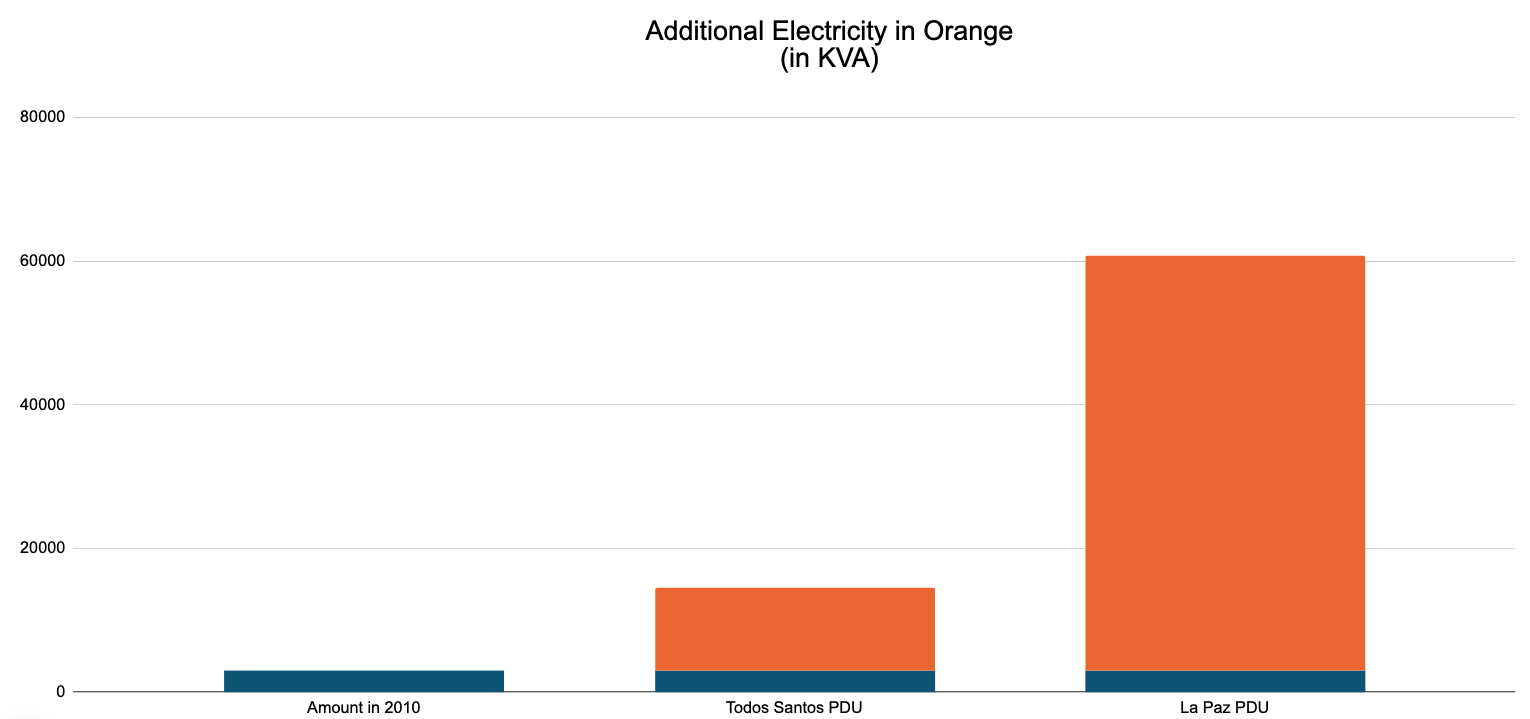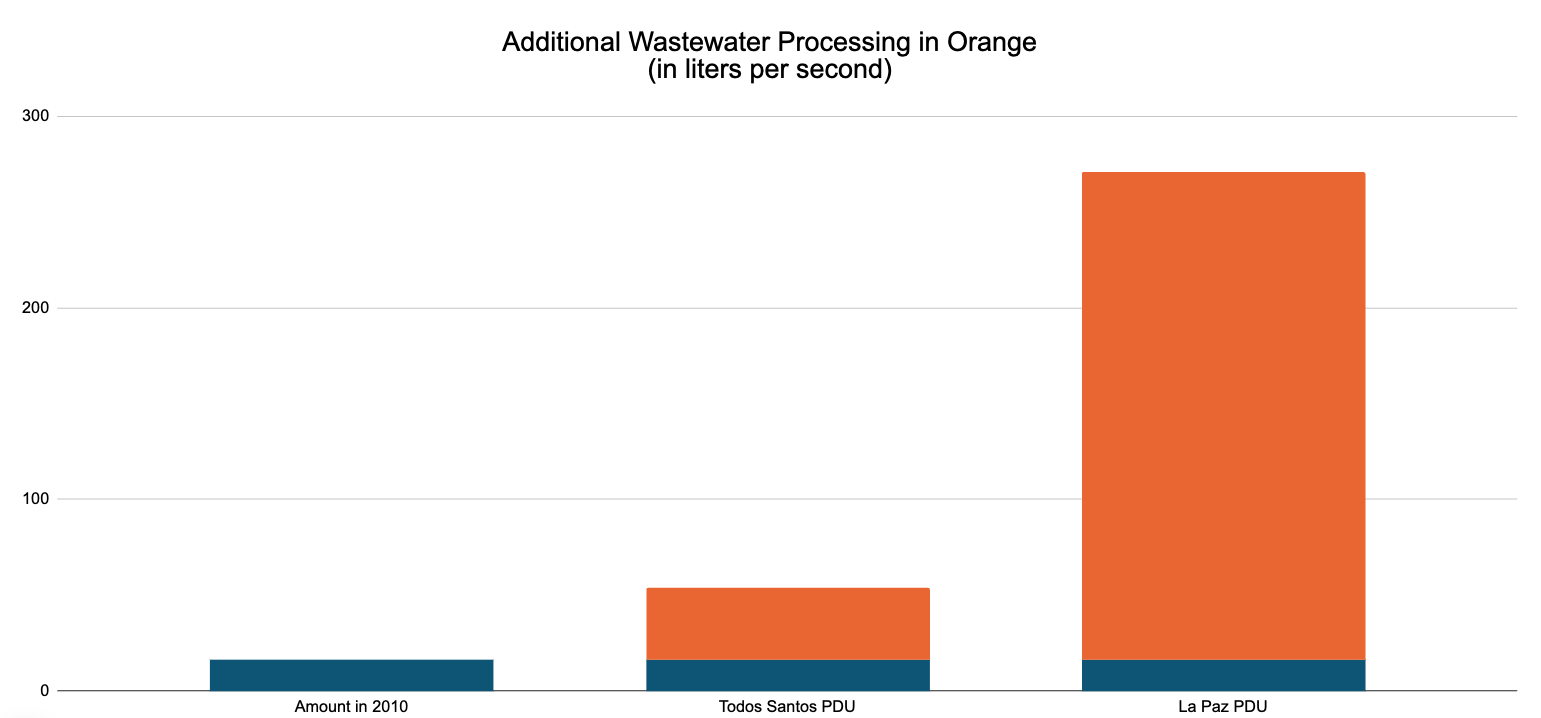
TODOS SANTOS LACK OF INFRASTRUCTURE
Anyone considering buying a home or lot in the Todos Santos region should be aware of the sever lack of water and power distribution and wastewater treatment infrastructure. Should the proposed La Paz PDU be enacted by the courts currently reviewing it, the charts on this page demonstrate the severity of the impact on water and power which would cause the value of real estate to plummet.
Who is Responsible
The municipality in La Paz is responsible for providing the residents of Todos Santos with an adequate water distribution system to all homes and businesses along with sewage and wastewater treatment systems. In addition, CFE, the utility service for the country, is responsible for providing electrical production and distribution.
Unfortunately, even though we are the fastest growing region in Baja Sur, the municipality and CFE have provided no new infrastructure for decades and no investments are planned. Even in the proposed La Paz PDU, which wanted to grow the region to 150,000 inhabitants, no projects or funding sources were included for water, power, or wastewater treatment.
Problems with the Water Distribution System
On top of the problem of the Todos Santos Aquifer being over-extracted by 80%, it is estimated that as much as 40% of the water in the distribution system is lost to leaks. When leaks are repaired, they are simply wrapped with rubber tubing which is only a temporary fix, and they leak again.
According to the Todos Santos PDU potable water needed to be increased by 340% from .63 mm3 in 2010 to 2.7 mm3 in 2030 under the Todos Santos PDU and 11.3 mm3 if the La Paz PDU were to be enacted.
It should be noted that the average annual recharge of the aquifer indicated on the chart is only 3.7 mm3 per year and as much as 80% of that water is concessioned for agricultural use. As a result, supplying that amount of potable water to residents is simply impossible without the construction of a desalination plant.
Sources of Water for Residents
Protect Todos Santos conducted a survey of residents to determine where their water came from and how many hours per week and day they received water. The survey determined 60% of residents receive their water from OMSAPA, 25% (mostly in Cerritos) have their water trucked in because there is no water distribution system, and 15% (mostly in Pescadero) receive their water from the Ejido system.
The Uneven Distribution of OMSAPA Water
Our resident survey found that in the Todos Santos Town Center, Las Brisas, San Sebastian, La Poza and La Cachora residents are receiving an almost continuous supply of water 5-6 days per week from OMSAPA. This is because they are near the aquifer.
Farther from the aquifer in the Las Tunas area north of Calle International, San Ignacio and Las Playitas OMSAPA water is only provided 1-2 days per week for 1 to 8 hours each of those days. Often it is not enough water to fill cisterns, so residents need to have additional water trucked in.
Lack of water is the result of the lack of adequate water pressure. As new homes were built, OMSAPA simply tied them into the existing lines and mains without installing larger pipes to increase the capacity needed to serve the additional homes. The solution to this problem would be to increase the size of piping in some areas and add pumps to the system to supply water more frequently, but there are no plans or funding in place to do so.
Problems with the Electrical Grid
Ninety percent of the electricity in Baja Sur comes from a single power plant in La Paz. The power is distributed to the Todos Santos Region by a single 50-year-old distribution line. Due to recent growth and the failure to add capacity to the distribution line beginning in 2022 the region began experiencing daily brownouts and multiple weekly power outages during the summer months of July to October.
The KVA is a measure of power that includes voltage and current in the distribution grid. Based upon the estimated population growth under the Todos Santos PDU the KVA needed to be increased by 390% from 2,965 to 14,535 by 2030. The KVA would have needed to be increased to 60,815 if the La Paz PDU were to be enacted.
Resident Survey Results for Power
We asked residents how many times per week they lost power for more than a few minutes over the past 2 summers when power outages became a serious problem.
The survey determined a third of respondents experienced power outages 1-2 times per week for various lengths of time. A third said power outages occurred in their area 3 to 5 times per week and a third said power outages occurred in their area 6 to 7 times per week. In other words, power outages occur on average 3-5 times per week.
Damage to Appliances Caused by Uneven Voltage
The survey responses determined the lack of power from the power plant and distribution system also results in uneven voltage being delivered to homes and businesses causing thousands of appliances and pumps to fail. Voltage supplied by CFE should be in the 110–120-volt range but ends up being in the 90 - 140-volt range. Voltage below 95 often results in cistern pumps, pool pumps, and the compressors in air conditioners, and refrigerators being overworked and burnt out.
Alternatively, high voltage spikes, typically following brownouts, damage the electronics found in appliances, televisions, and computers. Of the 149 households that responded to the survey, 48 or one third of the households reported a total of 104 electrical items destroyed by uneven voltage requiring replacement. These included 19 refrigerators, 13 cistern pumps, 11 air conditioners, 11 pool pumps, 8 computers, 7 washing machines, 3 clothes dryers, 4 televisions, 2 dishwashers, 2 electrical transformers and 24 small miscellaneous small appliances.
It should be noted that this survey of 149 respondents only represents about 2.5% of the approximately 6,000 households in the region, so the amount of damaged equipment could be in the range of 4,000 to 5,000 appliances and pumps, as much as $6 million worth of losses.
Wastewater Treatment
There is only a single privately funded and operated wastewater treatment plant located in the region.
Wastewater processing capacity was 16.5 liters per second in 2010 and needed to increase by 227% to 54 liters per second under the Todos Santos PDU and another 500% to 271 liters per second if the La Paz PDU were to be enacted.
Currently there is no plan or funding to create additional wastewater treatment capacity, and it is suspected a lot of the wastewater is being illegally dumped into the environment.
Get Involved
Contact Us
We need your help to protect Todos Santos.
If you observe any violations of the PDU and environmental regulations included on this website, please contact us, and we will investigate your concerns and take appropriate action.
Join Us
We are a group of citizens doing our best to protect our beautiful pueblo. We would love to have your help as we work to fight against illegal development and create more regulation and oversight into our limited natural resources.
Support Us
Your donation will help us stop illegal development, protect our current zoning rules, and fund our efforts to effectively manage our scarce water resources.



